Cooking with Local Bee Products for Eco-Friendly Sweetness
In today’s world, where we’re all trying to be a bit kinder to our planet, finding eco-friendly ways to sweeten up our lives—and our foods—is more important than ever. One delicious and sustainable way to do this is by using local bee products in our cooking. Not only do these natural goodies offer unique flavors that can elevate your dishes, but they also help support healthy ecosystems and local communities. Let’s dive into the sweet world of cooking with honey, bee pollen, and other bee-derived wonders!
The Sweetness of Local Honey
Honey is the most famous product made by bees, and its taste can vary dramatically depending on where it’s from. This is because bees produce honey from the nectar of the flowers that are blooming in their area, so each batch of local honey is a unique reflection of its landscape. When you cook with local honey, you’re not just adding sweetness; you’re incorporating the very essence of your local flora into your dishes. This can bring an intriguing depth of flavor to everything from baked goods to dressings and marinades.
But local honey isn’t just delicious—it’s also a more eco-friendly option than sugar. Bees play a crucial role in pollinating many of the crops we rely on, and supporting local beekeepers helps maintain healthy bee populations, which are essential for a thriving ecosystem. Plus, opting for local honey cuts down on the carbon footprint associated with transporting goods over long distances.
Bee Pollen: Nature’s Multivitamin
Another bee product that’s making waves in the culinary world is bee pollen. Often referred to as nature’s multivitamin, bee pollen is packed with proteins, vitamins, and minerals. It has a slightly sweet, floral taste and can be used to sprinkle over salads, yogurts, or blended into smoothies for an extra burst of nutrients. Just like honey, the flavor and nutritional profile of bee pollen can vary depending on the plants the bees have visited, making it another exciting, local ingredient to explore in your cooking.
Propolis and Royal Jelly: The Hidden Gems
Though not as well-known as honey and bee pollen, propolis and royal jelly are two other bee products that can add uniqueness to your culinary creations. Propolis, a resin-like material bees use to seal small gaps in their hives, is believed to have anti-inflammatory and antibacterial properties. It can be found in various health food products and, while its distinct, somewhat bitter flavor may not suit everyone’s taste for direct cooking, it can be an interesting addition to homemade remedies or health drinks.
Royal Jelly, the exclusive food of the queen bee, is renowned for its health benefits, including its antioxidant properties. It’s a creamy substance with a complex, slightly tangy taste that can be used sparingly in smoothies, desserts, and other dishes for a nutritional boost.
Cooking Tips and Ideas
-
Start Sweet, Start Simple: If you’re new to cooking with bee products, begin by replacing the sugar in your recipes with honey. Remember that honey is sweeter than sugar, so you’ll typically want to use less of it.
-
Salad Dressings and Marinades: Mix honey with olive oil, vinegar, and your choice of herbs for a delightful salad dressing. For marinades, honey’s natural sugars caramelize under heat, adding a delicious glaze to grilled meats or veggies.
-
Baking with Bee Pollen: Sprinkle bee pollen on top of baked goods for a nutritional boost and a pop of color. It can add a delightful crunch and subtle sweetness to cookies, muffins, and bread.
-
Eco-Friendly Sweetener: Embrace local honey as your go-to eco-friendly sweetener. By doing so, you’re supporting local bee populations and reducing your carbon footprint.
Conclusion
Incorporating local bee products into your cooking is a delightful and sustainable way to explore new flavors while supporting the environment. Each product, from honey to royal jelly, offers unique health benefits and an opportunity to connect with the natural world around us. By choosing local bee products, we not only add eco-friendly sweetness to our dishes but also contribute to the preservation of our precious ecosystems. So next time you’re in the kitchen, consider reaching for that jar of local honey or sprinkle of bee pollen and discover the sweet, sustainable magic they can bring to your cooking.


